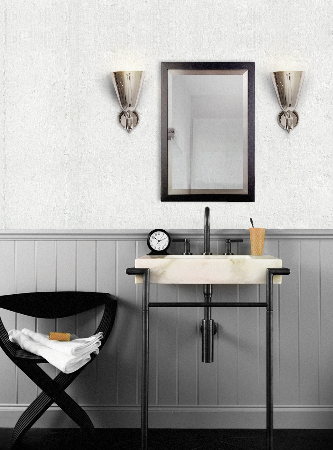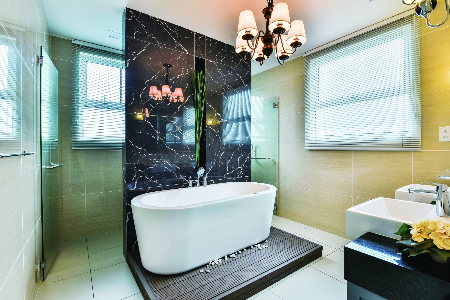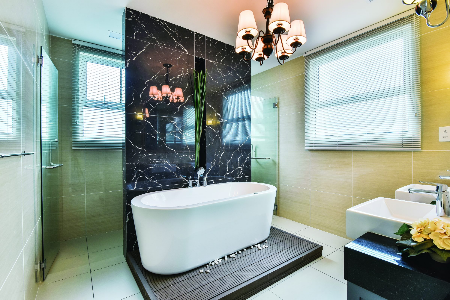Blog categories
Blog archive
RSS Blog posts tagged with 'tiles'
Blog Filters
Creative Details to Transform a Bathroom
Friday, November 20, 2020
Whether you desire a back-to-basics approach, or a something a little dramatic for your bathroom, there are plenty of ways to do so in your bathing spaces.
Bathrooms are no longer spaces that you hide away. While most remain enclosed, what goes on behind closed doors in modern bathrooms today can rival those we see in spas. This said, bathrooms have evolved into rooms that convey comfort, style and luxury. From the utilization of stylish tiles to interesting designs seen on tubs and toilets, these spaces offer plenty of design opportunities.
 Image Credit: DelightFULL
Image Credit: DelightFULL
To successfully makeover your bathroom, it’s important to know how you would be using the space. Maybe you just need a tub, or you prefer both a tub and shower stall in the same space. To put in a vibrant touch, there are many decorative bathing accessories out there to match the style you are going for.
Tile Immersion
Tiles are a wonderful way to add colour and depth to your bathroom space. It can also be used to define different spaces. It's best to keep the shower stall area in a clean and simple tone, but you can always play with more colours and patterns at the basin and WC area to draw the eyes away from the toilet.
 Image Credit: KSL Living
Image Credit: KSL Living
Encased in glass, this shower enclosure is set in grey tiles against a neutral background, offering a minimalist look. The sink and fittings are complemented by bathroom accessories, creating a well put together look. Form and function complement each other beautifully in the small shower area.
 Tip: If you're looking to create a unique tile pattern, stick to no more than three tiles that share the same colour palette. Using too many types of tiles can become a distraction to the eye and also become more difficult to place. Image Credit: KSL Living
Tip: If you're looking to create a unique tile pattern, stick to no more than three tiles that share the same colour palette. Using too many types of tiles can become a distraction to the eye and also become more difficult to place. Image Credit: KSL Living
Soak in Style
The bathtub is a defining feature in the bathroom. To set a focal point, you can get a tub that has an ornate quality to it. Consider a standalone tub, perhaps in a different colour to create an attention-grabbing element in your space. Keep the rest of the backdrop clean and neutral so that the tub stands out.
 Image Credit: Mylands Paints
Image Credit: Mylands Paints
For this mid-century styled bathroom, the designer incorporated a tub painted in a dusky pink tone. Set atop elegant claw feet, this beautiful bath adds instant sophistication to the space. The motif of the floor tiles stands out against the dark wood cabinets that line the walls. To put in a feminine touch, floral decoration is used to match the ornate quality in this space.
 Tip: If you are painting your bathtub, only use paint intended for bathtubs, tile, and sinks. Under no circumstances should you use regular paint (not made specifically for bathtubs) as they are simply not designed to stand up under constant water conditions. Image Credit: Mylands Paints
Tip: If you are painting your bathtub, only use paint intended for bathtubs, tile, and sinks. Under no circumstances should you use regular paint (not made specifically for bathtubs) as they are simply not designed to stand up under constant water conditions. Image Credit: Mylands Paints
Dip into Details
 Image Credit: Bathroom Takeaway
Image Credit: Bathroom Takeaway
Just because the bathroom has a very utilitarian function, that doesn't mean you can't decorate it. In fact, when you put in little details, you can turn it into more than just a space for your daily washing routine - it can be a space at home you enjoy spending time in. There are actually plenty of opportunities here to transform it into your home spa.
 Image Credit: Bathroom Takeaway
Image Credit: Bathroom Takeaway
This bathroom is a wonderful example of what easy-to-apply decorative details can do. Indoor plants inject a fresh feeling, and the layering of earthy vases and baskets offsets the stark coldness of the wall and floor tiles. Not just merely decorative, these details can be functional too. For instance, little bathing accessories set over the tub or small furniture pieces.
White Wash
With small bathrooms, it's best to keep things simple and minimal. One of the best ways to do so is to go for an all-white palette. From tile to fixtures to vanities and accessories, a bathroom drenched in white is calm and peaceful, whether it’s steeped in tradition or sleekly modern. No matter the size of your bathroom, white palettes invite in light for a blissful, spa-like atmosphere.
 Image Credit: Bathroom Takeaway
Image Credit: Bathroom Takeaway
White also helps to bounce light in a room which helps with enlarging the space visually. Additionally, this colour gives your a bathroom versatile backdrop where you can add on your favourite accessories to enliven the ambience and give it a unique personality.
 Tip: Blend a variety of materials to keep an all-white room from looking sterile. Sleek and shiny white tiles look softer next to a painted wood vanity. Image Credit: Bathroom Takeaway
Tip: Blend a variety of materials to keep an all-white room from looking sterile. Sleek and shiny white tiles look softer next to a painted wood vanity. Image Credit: Bathroom Takeaway
In this bathroom, the white tub, WC and sink come together beautifully against the white wall and white tiles on the floor. The designer has opted for a light grey concrete-like wall on the left side which adds depth and texture to the overall space. The little niches punctuated into the white wall complemented by decorative features are a nice touch to bring out visual interest.
Bold Splash
 Interior design by: Vitaliy Yorov and Iryna Dzhemesiuk via Maison Valentina
Interior design by: Vitaliy Yorov and Iryna Dzhemesiuk via Maison Valentina
Forget straight lines and boxy features for the bathroom. Tubs don't need to be white and rectangle all the time. You can also go for something less conventional for the sinks and other fittings. It may sound a little risky to take a bold approach for this space, but when done well, it can add on a wonderful wow factor for your home. Take this bathroom for instance. A black tub juxtaposed against a shimmering wall of blue glass elements anchors the space with an eye-catching effect. It is dramatic, yet the choice of solid colours brings the entire composition together to a cohesive whole that's luxurious and glamorous at the same time. The artistic mirror also blends in beautifully with the decor to further enhance the design concept.
[gallery columns="2" size="medium" ids="57651,57650"]Sensorial Appeal
 Image Credit: hansgrohe
Image Credit: hansgrohe
A luxurious bathroom should ideally allow for an enjoyable and sensual bathing experience. For instance, the lighting of the bathroom space, the texture of the materials and the fragrance used in the bathroom are important in creating a relaxing atmosphere for some personal me-time.
 Image Credit: hansgrohe
Image Credit: hansgrohe
Refined finishes bring joy, including fine grains in natural stone, non-slip wood, marbled tiles and the pattern of small mosaics and tiles. These bathroom companions, as featured in the Martin Modern condo, have structures that please the eye and turn the bathroom into a luxurious and inviting space, bringing about a more pleasurable experience and encouraging a longer stay in the bathroom.
[gallery columns="2" size="medium" ids="57649,57648"]Article by: Lily Wong

10 Ways You Can Use Tiles to Enhance Your Bathroom
Friday, November 20, 2020
If you find yourself bewildered at the range of tiles presented in your local showroom, this guide will be your rock.
Whether you are starting out with a bare cement floor, or you are faced with an aging bathroom in need of an update, there is a wide range of things that can be done with just tiles. While the default option of decking the entire bathroom in white stone may seem like the most practical choice for a clean appearance, there would be some missed opportunities for creating a unique décor in a space that most people would not expect to find a memorable interior.
 Interior design by: Nice-Style Refurbishment
Interior design by: Nice-Style Refurbishment
In pursuit of providing you with some inspiration, we took on the task of analysing the art and science of tiling: from the selection of tiles on the bases of shade, shape, texture, and size, to the installation of tiles in different orientations, arrangements, patterns, and locations. Before settling on your choice of tiles, take a look at the following ten ways of enhancing your bathroom for some ideas.
The Rule of Threes
 Interior design by: GI Design
Interior design by: GI Design
As a general rule, the formula for any balanced visual arrangement calls for a set of three elements to be used together. In the case of tiling a space as small as the average bathroom, a useful axiom to apply is to use no more than three different tiles in order to keep the arrangement from becoming overly chaotic - one for the floor, another for the walls, and a third variety for accents. As with all the other unwritten rules purporting to govern art, this guideline can be reduced for the sake of simplicity, or expanded for intricate complexity.
 Interior design by: Hoe & Yin Design Studio
Interior design by: Hoe & Yin Design Studio
Light or Dark Shade
 Interior design by: Nu Infinity
Interior design by: Nu Infinity
The shade of tiles you select contribute to either a light or dark ensemble in the bathroom, producing differing results depending on the amount of sunlight received in the space over the course of a day. Bathrooms that receive little natural light benefit from tiles in pale shades that maximise the light, while bathrooms with an abundance of sunlight are afforded the option of going darker for a more masculine result.
 Interior design by: Desenzes Interior Concept
Interior design by: Desenzes Interior Concept
Serene or Vibrant Mood
 Interior design by: The Roof Studio
Interior design by: The Roof Studio
Envision the end result you want and select tiles to achieve that end, or start with a tile you adore and build a set with complementing or contrasting tiles to suit. Either way, one should be aware of the fact that the tiles you select will go towards creating either a serene arrangement made up of complementary shades and finishes, or a vibrant assembly composed of high-definition contrasts in colour and texture.
Natural or Polished Finish
 Interior design by: Jashen Interior
Interior design by: Jashen Interior
While browsing for tiles in the ideal shade, you would have invariably come across mentions of a natural or polished finish as well. Tiles with a rough finish are appealing to purists for their natural feel, but they also serve the practical function of providing some friction for wet feet. A polished finish may entail some caution when used underfoot, but the result is an elegant and reflective surface that expands the space.
 Interior design by: M Innovative Builders
Interior design by: M Innovative Builders
Engineered Texture
 Interior design by: Architrio
Interior design by: Architrio
The repeating patterns and textures that do not appear in nature are instead machined into tiles for an eye-catching presentation - especially when used in isolated pockets highlighting functional areas of the bathroom such as the commode and shower enclosure. Tiles with high-definition textures should be used in limited amounts to keep the arrangement from appearing overly complicated.
 The relative blandness of all-white tiles can be offset by decking an adjacent plane with detailed decorative tiles for contrast, such as the monochromatic ethnic motifs presented on the bathroom floor. Interior design by: Viincology
The relative blandness of all-white tiles can be offset by decking an adjacent plane with detailed decorative tiles for contrast, such as the monochromatic ethnic motifs presented on the bathroom floor. Interior design by: Viincology
Forced Perspective
 Interior design by: Nu Infinity
Interior design by: Nu Infinity
A technique of visual composition utilised in cinematography, forced perspective entails the placement of objects reduced in scale to make nearby objects, or the space containing them, seem larger. In the context of tiling your bathroom, compact areas such as a narrow shower enclosure could be made to appear wider with the application of small tiles.
Wood Mimicry
 Interior design by: Yong Studio
Interior design by: Yong Studio
One of the most understated revolutions in architectural finishes occurred when the first tiles mimicking wood rolled off the presses. These tiles combine the warm and unique aesthetics of wood with the practicality and durability of manufactured tiles. As with tiles bearing engineered textures, these unique tiles should be used in small measures, ideally to demarcate shower or bath enclosures, so as not to overwhelm the whole assembly.
Grout Colour and Thickness
 Interior design by: Soul Frame
Interior design by: Soul Frame
A detail of tiling that often goes overlooked is grouting - the lines of sand and cement or plaster used to adhere tiles to the floor slab that visibly seep out through the gaps between tiles. As grout is typically based on plaster or ordinary Portland cement, it can be applied in varying compositions and colours. The overall appearance of your tiles can be affected by selecting a contrasting colour for clearly defined lines between tiles, or a complementary colour for subtlety - with thickness having an effect on the cohesion of the arrangement. Thick lines serve to segregate the tiles for a look best suited to country or classically inspired spaces, while thin lines integrate tiles into presentations suited for modern and minimalist interiors.
 Interior design by: IDS Interior
Interior design by: IDS Interior
Horizontal Orientation
 Interior design by: Gusto Design
Interior design by: Gusto Design
As most bathrooms are relatively small spaces, they benefit from the space-expanding effects of horizontally-oriented tiles on any plane: floor or wall. Tiles are generally sold in rectangular dimensions, making the basic grid arrangement an accessible pattern at reasonable cost.
Non-Standard Arrangements
 Interior design by: Homlux Interior Furnishing
Interior design by: Homlux Interior Furnishing
For those who find the standard grid arrangement to be too conventional, a brick pattern may bear some surprising results - even more so when laid in a bold diagonal orientation to resemble the dependable herringbone pattern. For those who open the door to look in on non-standard arrangements, they will find themselves going down a path less travelled, through a landscape of non-standard shapes and mind-bending patterns.
 Interior design by: JCS Design Project
Interior design by: JCS Design Project

Creative Details to Transform a Bathroom
Friday, November 20, 2020
Whether you desire a back-to-basics approach, or a something a little dramatic for your bathroom, there are plenty of ways to do so in your bathing spaces.
Bathrooms are no longer spaces that you hide away. While most remain enclosed, what goes on behind closed doors in modern bathrooms today can rival those we see in spas. This said, bathrooms have evolved into rooms that convey comfort, style and luxury. From the utilization of stylish tiles to interesting designs seen on tubs and toilets, these spaces offer plenty of design opportunities.
 Image Credit: DelightFULL
Image Credit: DelightFULL
To successfully makeover your bathroom, it’s important to know how you would be using the space. Maybe you just need a tub, or you prefer both a tub and shower stall in the same space. To put in a vibrant touch, there are many decorative bathing accessories out there to match the style you are going for.
Tile Immersion
Tiles are a wonderful way to add colour and depth to your bathroom space. It can also be used to define different spaces. It's best to keep the shower stall area in a clean and simple tone, but you can always play with more colours and patterns at the basin and WC area to draw the eyes away from the toilet.
 Image Credit: KSL Living
Image Credit: KSL Living
Encased in glass, this shower enclosure is set in grey tiles against a neutral background, offering a minimalist look. The sink and fittings are complemented by bathroom accessories, creating a well put together look. Form and function complement each other beautifully in the small shower area.
 Tip: If you're looking to create a unique tile pattern, stick to no more than three tiles that share the same colour palette. Using too many types of tiles can become a distraction to the eye and also become more difficult to place. Image Credit: KSL Living
Tip: If you're looking to create a unique tile pattern, stick to no more than three tiles that share the same colour palette. Using too many types of tiles can become a distraction to the eye and also become more difficult to place. Image Credit: KSL Living
Soak in Style
The bathtub is a defining feature in the bathroom. To set a focal point, you can get a tub that has an ornate quality to it. Consider a standalone tub, perhaps in a different colour to create an attention-grabbing element in your space. Keep the rest of the backdrop clean and neutral so that the tub stands out.
 Image Credit: Mylands Paints
Image Credit: Mylands Paints
For this mid-century styled bathroom, the designer incorporated a tub painted in a dusky pink tone. Set atop elegant claw feet, this beautiful bath adds instant sophistication to the space. The motif of the floor tiles stands out against the dark wood cabinets that line the walls. To put in a feminine touch, floral decoration is used to match the ornate quality in this space.
 Tip: If you are painting your bathtub, only use paint intended for bathtubs, tile, and sinks. Under no circumstances should you use regular paint (not made specifically for bathtubs) as they are simply not designed to stand up under constant water conditions. Image Credit: Mylands Paints
Tip: If you are painting your bathtub, only use paint intended for bathtubs, tile, and sinks. Under no circumstances should you use regular paint (not made specifically for bathtubs) as they are simply not designed to stand up under constant water conditions. Image Credit: Mylands Paints
Dip into Details
 Image Credit: Bathroom Takeaway
Image Credit: Bathroom Takeaway
Just because the bathroom has a very utilitarian function, that doesn't mean you can't decorate it. In fact, when you put in little details, you can turn it into more than just a space for your daily washing routine - it can be a space at home you enjoy spending time in. There are actually plenty of opportunities here to transform it into your home spa.
 Image Credit: Bathroom Takeaway
Image Credit: Bathroom Takeaway
This bathroom is a wonderful example of what easy-to-apply decorative details can do. Indoor plants inject a fresh feeling, and the layering of earthy vases and baskets offsets the stark coldness of the wall and floor tiles. Not just merely decorative, these details can be functional too. For instance, little bathing accessories set over the tub or small furniture pieces.
White Wash
With small bathrooms, it's best to keep things simple and minimal. One of the best ways to do so is to go for an all-white palette. From tile to fixtures to vanities and accessories, a bathroom drenched in white is calm and peaceful, whether it’s steeped in tradition or sleekly modern. No matter the size of your bathroom, white palettes invite in light for a blissful, spa-like atmosphere.
 Image Credit: Bathroom Takeaway
Image Credit: Bathroom Takeaway
White also helps to bounce light in a room which helps with enlarging the space visually. Additionally, this colour gives your a bathroom versatile backdrop where you can add on your favourite accessories to enliven the ambience and give it a unique personality.
 Tip: Blend a variety of materials to keep an all-white room from looking sterile. Sleek and shiny white tiles look softer next to a painted wood vanity. Image Credit: Bathroom Takeaway
Tip: Blend a variety of materials to keep an all-white room from looking sterile. Sleek and shiny white tiles look softer next to a painted wood vanity. Image Credit: Bathroom Takeaway
In this bathroom, the white tub, WC and sink come together beautifully against the white wall and white tiles on the floor. The designer has opted for a light grey concrete-like wall on the left side which adds depth and texture to the overall space. The little niches punctuated into the white wall complemented by decorative features are a nice touch to bring out visual interest.
Bold Splash
 Interior design by: Vitaliy Yorov and Iryna Dzhemesiuk via Maison Valentina
Interior design by: Vitaliy Yorov and Iryna Dzhemesiuk via Maison Valentina
Forget straight lines and boxy features for the bathroom. Tubs don't need to be white and rectangle all the time. You can also go for something less conventional for the sinks and other fittings. It may sound a little risky to take a bold approach for this space, but when done well, it can add on a wonderful wow factor for your home. Take this bathroom for instance. A black tub juxtaposed against a shimmering wall of blue glass elements anchors the space with an eye-catching effect. It is dramatic, yet the choice of solid colours brings the entire composition together to a cohesive whole that's luxurious and glamorous at the same time. The artistic mirror also blends in beautifully with the decor to further enhance the design concept.
[gallery columns="2" size="medium" ids="57651,57650"]Sensorial Appeal
 Image Credit: hansgrohe
Image Credit: hansgrohe
A luxurious bathroom should ideally allow for an enjoyable and sensual bathing experience. For instance, the lighting of the bathroom space, the texture of the materials and the fragrance used in the bathroom are important in creating a relaxing atmosphere for some personal me-time.
 Image Credit: hansgrohe
Image Credit: hansgrohe
Refined finishes bring joy, including fine grains in natural stone, non-slip wood, marbled tiles and the pattern of small mosaics and tiles. These bathroom companions, as featured in the Martin Modern condo, have structures that please the eye and turn the bathroom into a luxurious and inviting space, bringing about a more pleasurable experience and encouraging a longer stay in the bathroom.
[gallery columns="2" size="medium" ids="57649,57648"]Article by: Lily Wong

10 Ways You Can Use Tiles to Enhance Your Bathroom
Friday, November 20, 2020
If you find yourself bewildered at the range of tiles presented in your local showroom, this guide will be your rock.
Whether you are starting out with a bare cement floor, or you are faced with an aging bathroom in need of an update, there is a wide range of things that can be done with just tiles. While the default option of decking the entire bathroom in white stone may seem like the most practical choice for a clean appearance, there would be some missed opportunities for creating a unique décor in a space that most people would not expect to find a memorable interior.
 Interior design by: Nice-Style Refurbishment
Interior design by: Nice-Style Refurbishment
In pursuit of providing you with some inspiration, we took on the task of analysing the art and science of tiling: from the selection of tiles on the bases of shade, shape, texture, and size, to the installation of tiles in different orientations, arrangements, patterns, and locations. Before settling on your choice of tiles, take a look at the following ten ways of enhancing your bathroom for some ideas.
The Rule of Threes
 Interior design by: GI Design
Interior design by: GI Design
As a general rule, the formula for any balanced visual arrangement calls for a set of three elements to be used together. In the case of tiling a space as small as the average bathroom, a useful axiom to apply is to use no more than three different tiles in order to keep the arrangement from becoming overly chaotic - one for the floor, another for the walls, and a third variety for accents. As with all the other unwritten rules purporting to govern art, this guideline can be reduced for the sake of simplicity, or expanded for intricate complexity.
 Interior design by: Hoe & Yin Design Studio
Interior design by: Hoe & Yin Design Studio
Light or Dark Shade
 Interior design by: Nu Infinity
Interior design by: Nu Infinity
The shade of tiles you select contribute to either a light or dark ensemble in the bathroom, producing differing results depending on the amount of sunlight received in the space over the course of a day. Bathrooms that receive little natural light benefit from tiles in pale shades that maximise the light, while bathrooms with an abundance of sunlight are afforded the option of going darker for a more masculine result.
 Interior design by: Desenzes Interior Concept
Interior design by: Desenzes Interior Concept
Serene or Vibrant Mood
 Interior design by: The Roof Studio
Interior design by: The Roof Studio
Envision the end result you want and select tiles to achieve that end, or start with a tile you adore and build a set with complementing or contrasting tiles to suit. Either way, one should be aware of the fact that the tiles you select will go towards creating either a serene arrangement made up of complementary shades and finishes, or a vibrant assembly composed of high-definition contrasts in colour and texture.
Natural or Polished Finish
 Interior design by: Jashen Interior
Interior design by: Jashen Interior
While browsing for tiles in the ideal shade, you would have invariably come across mentions of a natural or polished finish as well. Tiles with a rough finish are appealing to purists for their natural feel, but they also serve the practical function of providing some friction for wet feet. A polished finish may entail some caution when used underfoot, but the result is an elegant and reflective surface that expands the space.
 Interior design by: M Innovative Builders
Interior design by: M Innovative Builders
Engineered Texture
 Interior design by: Architrio
Interior design by: Architrio
The repeating patterns and textures that do not appear in nature are instead machined into tiles for an eye-catching presentation - especially when used in isolated pockets highlighting functional areas of the bathroom such as the commode and shower enclosure. Tiles with high-definition textures should be used in limited amounts to keep the arrangement from appearing overly complicated.
 The relative blandness of all-white tiles can be offset by decking an adjacent plane with detailed decorative tiles for contrast, such as the monochromatic ethnic motifs presented on the bathroom floor. Interior design by: Viincology
The relative blandness of all-white tiles can be offset by decking an adjacent plane with detailed decorative tiles for contrast, such as the monochromatic ethnic motifs presented on the bathroom floor. Interior design by: Viincology
Forced Perspective
 Interior design by: Nu Infinity
Interior design by: Nu Infinity
A technique of visual composition utilised in cinematography, forced perspective entails the placement of objects reduced in scale to make nearby objects, or the space containing them, seem larger. In the context of tiling your bathroom, compact areas such as a narrow shower enclosure could be made to appear wider with the application of small tiles.
Wood Mimicry
 Interior design by: Yong Studio
Interior design by: Yong Studio
One of the most understated revolutions in architectural finishes occurred when the first tiles mimicking wood rolled off the presses. These tiles combine the warm and unique aesthetics of wood with the practicality and durability of manufactured tiles. As with tiles bearing engineered textures, these unique tiles should be used in small measures, ideally to demarcate shower or bath enclosures, so as not to overwhelm the whole assembly.
Grout Colour and Thickness
 Interior design by: Soul Frame
Interior design by: Soul Frame
A detail of tiling that often goes overlooked is grouting - the lines of sand and cement or plaster used to adhere tiles to the floor slab that visibly seep out through the gaps between tiles. As grout is typically based on plaster or ordinary Portland cement, it can be applied in varying compositions and colours. The overall appearance of your tiles can be affected by selecting a contrasting colour for clearly defined lines between tiles, or a complementary colour for subtlety - with thickness having an effect on the cohesion of the arrangement. Thick lines serve to segregate the tiles for a look best suited to country or classically inspired spaces, while thin lines integrate tiles into presentations suited for modern and minimalist interiors.
 Interior design by: IDS Interior
Interior design by: IDS Interior
Horizontal Orientation
 Interior design by: Gusto Design
Interior design by: Gusto Design
As most bathrooms are relatively small spaces, they benefit from the space-expanding effects of horizontally-oriented tiles on any plane: floor or wall. Tiles are generally sold in rectangular dimensions, making the basic grid arrangement an accessible pattern at reasonable cost.
Non-Standard Arrangements
 Interior design by: Homlux Interior Furnishing
Interior design by: Homlux Interior Furnishing
For those who find the standard grid arrangement to be too conventional, a brick pattern may bear some surprising results - even more so when laid in a bold diagonal orientation to resemble the dependable herringbone pattern. For those who open the door to look in on non-standard arrangements, they will find themselves going down a path less travelled, through a landscape of non-standard shapes and mind-bending patterns.
 Interior design by: JCS Design Project
Interior design by: JCS Design Project





